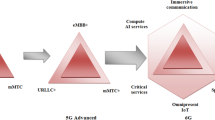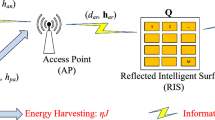Abstract
Cooperative communication is a crucial technology to sustain QoS of mobile user with increased energy efficiency. To improve QoS of cell edge users, energy efficiency and network utilization, cooperative communication can be used in heterogeneous networks. Source, destination and relays are multiple radio access nodes in heterogeneous networks hence source can communicate to relay and destination using one radio mode and relay can select some other efficient radio mode to retransmit message to destination. In this paper, QoS improved energy efficient radio mode and optimal relay(Q-EERR) selection algorithm with heterogeneous relays is proposed, in which each relay node considers dynamic variation of individual radio networks and efficiently select radio mode using Boltzmann–Gibb’s learning algorithm to retransmit message with required QoS and optimized energy. A novel heterogeneous relays introduced in proposed work act as store carry and forward relay (SCFR) for non real time services and decode and forward relay (DFR) for real time services. The proposed Q-EERR algorithm with heterogeneous relays is verified for real time services (voice and video conferencing), elastic service (FTP) and performances are compared with existing energy efficient relay and radio mode (EERR) selection algorithm with DFR and SCFR. It increases QoS of different services, network performance and reduces average transmit power compared with existing algorithm.









Similar content being viewed by others
References
Zhang, T., Zhao, S., Cuthbert, L., & Chen, Y. (2010). Energy-efficient cooperative relay selection scheme in MIMO relay cellular networks. In Proceedings of IEEE international conference on communication systems (ICCS) (pp. 269–273).
Devarajan, R., Jha, S. C., Phuyal, U., & Bhargava, V. K. (2011). Energy-aware user selection and power allocation for cooperative communication system with guaranteed quality-of-service. In Proceedings of Canadian workshop on information theory (pp. 206–210).
Zhang, W., Duan, D., & Yang, L. (2011). Relay selection from a battery energy efficiency perspective. IEEE Transactions on Communications, 59(6), 1525–1529.
Nie, C., Liu, P., Korakis, T., Erkip, E., & Panwar, S. S. (2013). Cooperative Relaying in Next-Generation Mobile WiMAX Networks. IEEE Transactions on Vehicular Technology, 62(3), 4608–4614.
Duan, L., Gao, L., & Huang, J. (2014). Cooperative spectrum sharing: A contract-based approach. IEEE Transactions on Mobile Computing, 13(1), 174–187.
Militano, L., & Araniti, G. (2014). Introducing fairness-efficiency trade-off for energy savings in wireless cooperative networks. Wireless Personal Communication: DOI. doi:10.1007/s11277-013-1483-3.
Feng, D., Jiang, C., Lim, G., Cimini, L. J., Jr., Feng, G., & Li, Y. G. (2013). A survey of energy-efficient wireless communications. IEEE Communication Surveys and Tutorials, 15(1), 167–175.
Choi, J., Xing, W., To, D., Wu, Y., & Xu, S. (2013). On the Energy Efficiency of a Relaying Protocol with HARQ-IR and Distributed Cooperative Beam forming”. IEEE Transactions on Wireless Communications, 12(2), 769–782.
Slimane, S.B., Zhou, B., & Li, X. (2008). Delay optimization in cooperative relaying with cyclic delay diversity. In Proceedings of IEEE international conference on communication (pp. 3553–3557).
Chong, Z., & Jorswieck, E.A. (2011). Energy efficiency in random opportunistic beam forming. In Proceedings of IEEE VTC (pp. 1–6).
Munasinghe, K., & Jamalipour, A. (2008). Interworking of WLAN–UMTS networks: An IMS-based platform for session mobility. IEEE Communications Magazine, 46, 184–191.
Xu, F., Zhang, L., & Zhou, Z. (2007). Interworking of WiMAX and 3GPP networks based on IMS. IEEE Communications Magazine, 45, 144–150.
Yang, S.-R., & Chen, W.-T. (2008). SIP multicast-based mobile quality-of-service support over heterogeneous IP multimedia subsystems. IEEE Transactions on Mobile Computing, 7(11), 1297–1311.
Zhang, Q., Fitzek, F.H.P., & Katz, M. (2006). Evolution of heterogeneous wireless networks: Towards cooperative networks. In Proceedings of conference of the center for information and communication technologies (CICT)—Mobile and wireless content, services and networks Short-term and long-term development trends (pp. 1–6).
Choi, Y., Lee, Y., & Cioffi, J. M. (2011). Optimization of cooperative interoperability in heterogeneous networks with cognitive ability. IEEE Communication Letters, 15(11), 1178–1180.
Wu, Y., Viswanathan, H., Klein, T., Haner, M., & Calderbank, R. (2011). Capacity optimization in networks with heterogeneous radio access technologies. In Proceedings 2011 IEEE Globecom.
Alves, H., Bennis, M., Souza, R. D., & Latva-aho, M. (2010). Enhanced performance of heterogeneous networks through full-duplex relaying. EURASIP Journal on Wireless Communications and Networking, 2012, 365.
Lim, G., & Cimini, L. J. (2012). Energy-efficient cooperative relaying in heterogeneous radio access networks. IEEE Communication Letters, 1(5), 476–479.
Lim, G., & Cimini,L.J. Jr. (2012). Energy- efficient best- select relaying in wireless cooperative networks. In Proceedings of 2012 IEEE CISS.
Trestian, R., Ormond, O., & Muntean, G. M. (2012). Game theory- based network selection: Solutions and challenges. IEEE Communications Surveys and Tutorials, 14(4), 1212–1231.
Trestian, R., Ormond, O., & Muntean, G.-M. (2011). Reputation based network selection using game theory. Elsevier Physical Communication, 4, 156–171.
Khan, M. A., Tembine, H., & Vasilakos, A. V. (2012). Game dynamics and cost of learning in heterogeneous 4G networks. IEEE Journal on Selected Areas in Communications, 30(1), 198–214.
Ma, D., & Ma, M. (2012). A QoS oriented vertical handoff scheme for WiMAX/WLAN overlay networks. IEEE Transactions on Parallel and Distributed Systems, 23(4), 598–607.
Hong, J., & Choi, W. (2010). Dynamically reconfigurable relay communications with multiple radio access technologies. IEEE Transactions on Vehicular Technology, 59(9), 4608–4614.
Peng, M., Wang, W., & Zhang, J. (2009). Performance analysis of multi-user diversity in heterogeneous cooperative communication systems. Journal on Wireless Netw, 16, 1903–1912.
Kolios, P., Friderikos, V., & Papadaki, K. (2014). Energy-Efficient Relaying via Store-Carry and Forward within the Cell. IEEE Transaction on Mobile Computing, 13(1), 202–215.
OPNET. (2013). Network modelling and application performance monitoring: Network simulator: Version 14A: OPNET Technologies, December 2013.
WiMAX Forum. (2008). Deployment of mobile WiMAX by operators with existing 2G and 3G networks, February 2008.
Author information
Authors and Affiliations
Corresponding author
Rights and permissions
About this article
Cite this article
Bharathi, V., Nithyanandan, L. QoS Improved Energy Efficient Cooperative Relaying in Heterogeneous Networks Using Heterogeneous Relays. Wireless Pers Commun 96, 4367–4384 (2017). https://doi.org/10.1007/s11277-017-4391-0
Published:
Issue Date:
DOI: https://doi.org/10.1007/s11277-017-4391-0




